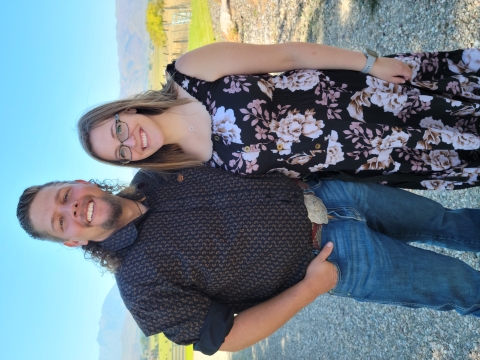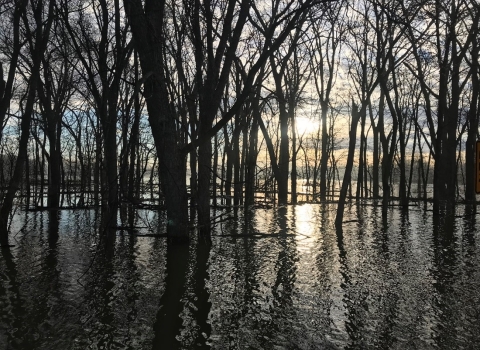Few kids get a sense of where they’re heading in life by age 10.
But in May 2000, Charlie Sandford experienced a natural disaster that greatly informed the life path he would follow.
What started as a controlled burn near his childhood home of Los Alamos, New Mexico, was quickly wind-whipped into a monstrous conflagration that destroyed 235 homes and displaced more than 400 people. All told, the Cerro Grande Fire burned 43,000 acres and caused about $1 billion in damage. Fortunately, no human lives were lost in the fire.
“I remember being fascinated by the fire, the firefighting and the recovery process,” says Charlie, now a wildlife biologist with the U.S. Fish and Wildlife Service.
Charlie and his parents spent many of the weekends that followed filling sandbags to reinforce rivers and channels in an effort to brace for the eventual erosion of the burned landscape. His neighbor, an ecologist, taught Charlie about fire recovery and the natural ecosystem.
The experience shaped Charlie’s entire future, from his career choice, to his passion for battling wildland fires and protecting the nation’s sage lands to his giving spirit.
While attending New Mexico State University, Charlie took a couple of summer internships with the Bureau of Land Management and the U.S. Forest Service in New Mexico and Montana.
“I had such a good experience in Montana that I looked for jobs up there when I graduated,” he says. Charlie landed a job with the Montana Department of Fish, Wildlife and Parks studying sage-grouse. The species is not on the Endangered Species Act list, but its numbers have steadily declined by about 2.3% a year since the 1960s. Its habitat is threatened by fire, invasive plant species and climate change climate change
Climate change includes both global warming driven by human-induced emissions of greenhouse gases and the resulting large-scale shifts in weather patterns. Though there have been previous periods of climatic change, since the mid-20th century humans have had an unprecedented impact on Earth's climate system and caused change on a global scale.
Learn more about climate change , among other things.
Charlie found the work so engaging and important, he decided to apply to Utah State University to pursue a master’s degree. He got an unlikely response.
“A professor called me and said, ‘Hey, I have your application. I like what you do. Do you want a position?’ I was like, ‘No, this is a scam. No one just calls you.’ He was like, ‘No, just be here in January and you’ve got a gig,’” Charlie recalls.
Charlie took the offer, moved to Utah, graduated, continued to study sage-grouse and in 2016 applied for his current position with the Service in Twin Falls, Idaho. He works in a shared position with the Bureau of Land Management to ensure all the various stakeholders can use land the way they need to but in a way that is safe for sage-grouse.
But sometimes, Charlie can be found on the front lines of wildfires. “We do have quite a few rangeland fires in the Great Basin, and actually tend to have more rangeland fires than forest fires in terms of quantity of acres,” Charlie says.
Charlie says this is a huge, often overlooked problem. “I think one of the reasons the sagebrush sagebrush
The western United States’ sagebrush country encompasses over 175 million acres of public and private lands. The sagebrush landscape provides many benefits to our rural economies and communities, and it serves as crucial habitat for a diversity of wildlife, including the iconic greater sage-grouse and over 350 other species.
Learn more about sagebrush ecosystem is imperiled is that it doesn’t fit our definition of pretty,” Charlie says of sagebrush country. “It’s a really important and surprisingly complex landscape that even offers habitat such as aspen trees and willows in canyons along streams. These hidden gems offer refuge for some of the same species we find in forests, like elk, deer, and beaver. … But there also are these specialists like antelope and sage-grouse that can only exist in the flatlands and the sagebrushy areas.”
In the decades it takes a tree to grow to 40 feet, sagebrush grows only knee-high.
“If we lose 100,000 acres a year and under great circumstances we get sagebrush back in 10 years, that’s a rolling 100,000 acres. That means we’ve lost a million acres in a decade and we’ve only recovered 100,000. It’s not a sustainable pace, but it doesn’t get a whole lot of attention because most people tend to focus on temperate landscapes like forests,” he says.
So it’s not uncommon for Charlie to throw on his wildland firefighting gear and get in the thick of a wildfire to try to help limit its damage.
“I love that,” he says of firefighting.
“I feel like it’s something that’s just innate. Part of it is having lived through a forest fire in my own community — the intensity, the human response to this very real emergency and the idea that every decision I make and those around me make is imperative to protect their safety but also to preserve habitat and minimize future workload,” he says. “A decision someone makes in 5 minutes to engage and fight a fire could save a thousand acres for decades.”
As Charlie continues to work to restore the sagebrush habitat and protect it from invasive species invasive species
An invasive species is any plant or animal that has spread or been introduced into a new area where they are, or could, cause harm to the environment, economy, or human, animal, or plant health. Their unwelcome presence can destroy ecosystems and cost millions of dollars.
Learn more about invasive species , he says he continues to stay excited about his work. “I know the work I’m doing and the money I’m spending of the public trust is actually improving habitat and improving resiliency to disturbance. “I hope I’m reducing fire intensity and maybe resulting in one more grouse or one more antelope or one more deer on the landscape,” he says.
In his off time, Charlie is no less giving. Before his wedding five years ago, Charlie had grown out his curly locks to donate. When he got his hair cut the week before his wedding, he told his wife he wanted to do it one more time.
In September 2020, as he got ready to have it cut, Charlie had a thought: “Wait a minute. When I trim my facial hair back, I cut it in phases to see what I’d look like with chops or a mustache or a full beard. What if I do that with my hair?”
So, without consulting his wife, Charlie donated most of his hair but kept 10 or 12 inches in the back for himself. Yes, he opted for a mullet, a haircut wildly popular in the 1980s for its business in the front, party in the back sensibility. “It was just hilarious!” he says. “She was like, why did you do this? This was a terrible idea!”
He promised her he would cut it off the day nobody says anything about his hairstyle.
That day has yet to come.
“We’ll go to the grocery store, we’ll go to a concert, and I guarantee people will go, ‘Dude, that’s a sweet mullet.’ I only meant to have it for a month as a prank and that was three years ago. I didn’t realize I’d created an alter ego for myself. But now I can’t really get rid of it because it’s become my identity.”
Charlie has also donated something far more precious than his hair. At some point, maybe a decade ago, he registered with Be the Match, the recruiting face for the National Bone Marrow Donor Registry. He’d forgotten about it until he got a call in late 2022 telling him he might be a match for a cancer patient.
After a bit more testing, it was determined he was a suitable match. “There are a lot of ways to donate, but technology has come far enough that bone marrow is rarely harvested anymore. I wound up donating stem cells instead of bone marrow, so it was just a quick blood procedure,” he says.
“It was a hugely rewarding experience. I don’t know who the person is, and I may never know, but that fact is there are people out there alive because a relatively painless procedure saves their life. After I signed up, I gave it almost no thought and now it’s almost all I think about,” Charlie says, encouraging others to go https://bethematch.org/ to learn more.
Circling back to his career, Charlie says he hopes other aspiring Service employees follow his path to the career, by looking for internships and seasonal jobs. “We’re in the world of the internet. Job postings can get hundreds of applicants. You’ve got to do something to stand out; a 4.0 GPA won’t do it, but maybe you showed up every day for your three-month seasonal job at a national park. I feel like it’s cliché, but the people I remember were the really hard workers and the folks who shaped my work ethic.
America loves its wildlife, both domestic and international, and that love of wild things and wild places helps define our character as a nation. We and our state partners face mounting pressures on the species we are entrusted to manage from threats such as habitat loss, climate change, wildlife disease and invasive species. Urgent action now can help the American people heal, minimize species decline, avert catastrophic invasive species takeover, build a more climate-resilient future, and address systemic exclusion of underrepresented people in wildlife conservation.





